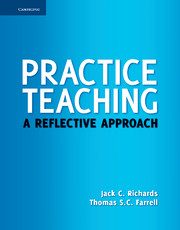Book contents
- Frontmatter
- Contents
- Introduction
- Chapter 1 Learning to Teach Through Practice Teaching
- Chapter 2 The Nature of Teacher Learning
- Chapter 3 Understanding the Teaching Context
- Chapter 4 Working With Your Cooperating Teacher
- Chapter 5 Planning Your Teaching
- Chapter 6 Teaching an Effective Language Lesson
- Chapter 7 Classroom Observation in Teaching Practice
- Chapter 8 Creating an Effective Classroom Learning Environment
- Chapter 9 Developing Learner-Centered Teaching
- Chapter 10 Classroom Discourse and Communication
- Chapter 11 Exploring Your Own Teaching
- Chapter 12 After Teaching Practice
- References
- Author Index
- Subject Index
Chapter 7 - Classroom Observation in Teaching Practice
Published online by Cambridge University Press: 05 October 2012
- Frontmatter
- Contents
- Introduction
- Chapter 1 Learning to Teach Through Practice Teaching
- Chapter 2 The Nature of Teacher Learning
- Chapter 3 Understanding the Teaching Context
- Chapter 4 Working With Your Cooperating Teacher
- Chapter 5 Planning Your Teaching
- Chapter 6 Teaching an Effective Language Lesson
- Chapter 7 Classroom Observation in Teaching Practice
- Chapter 8 Creating an Effective Classroom Learning Environment
- Chapter 9 Developing Learner-Centered Teaching
- Chapter 10 Classroom Discourse and Communication
- Chapter 11 Exploring Your Own Teaching
- Chapter 12 After Teaching Practice
- References
- Author Index
- Subject Index
Summary
INTRODUCTION
Observation plays a central role in practice teaching, both observation of your teaching by your cooperating teacher and supervisor, as well as your own observations of your cooperating teacher's class. Other school staff may also wish to observe one of your classes from time to time, such as the principal, the vice-principal, or a senior teacher, so you need to prepare well for every lesson in the event that someone asks to observe your teaching. You may also have the opportunity to observe other teachers in your host school and to review video recordings of your own teaching and that of other student teachers in your teaching practice seminars. The purpose and nature of observation, however, differs according to who participates in the observation process. For example, in observing your cooperating teacher's class your focus will be on how the teacher teaches, on such things as how the teacher creates a positive atmosphere for learning, on the strategies and procedures used by the teacher in setting up activities, on the way the teacher gives instructions and explanations, and how he or she gives feedback to learners. As a novice teacher you will not be evaluating your cooperating teacher's teaching. When you are being observed by your cooperating teacher or supervisor, however, the focus will often be on how well you carried out different aspects of the lesson. In this chapter we deal with both kinds of observations.
- Type
- Chapter
- Information
- Practice TeachingA Reflective Approach, pp. 90 - 105Publisher: Cambridge University PressPrint publication year: 2011
- 6
- Cited by



